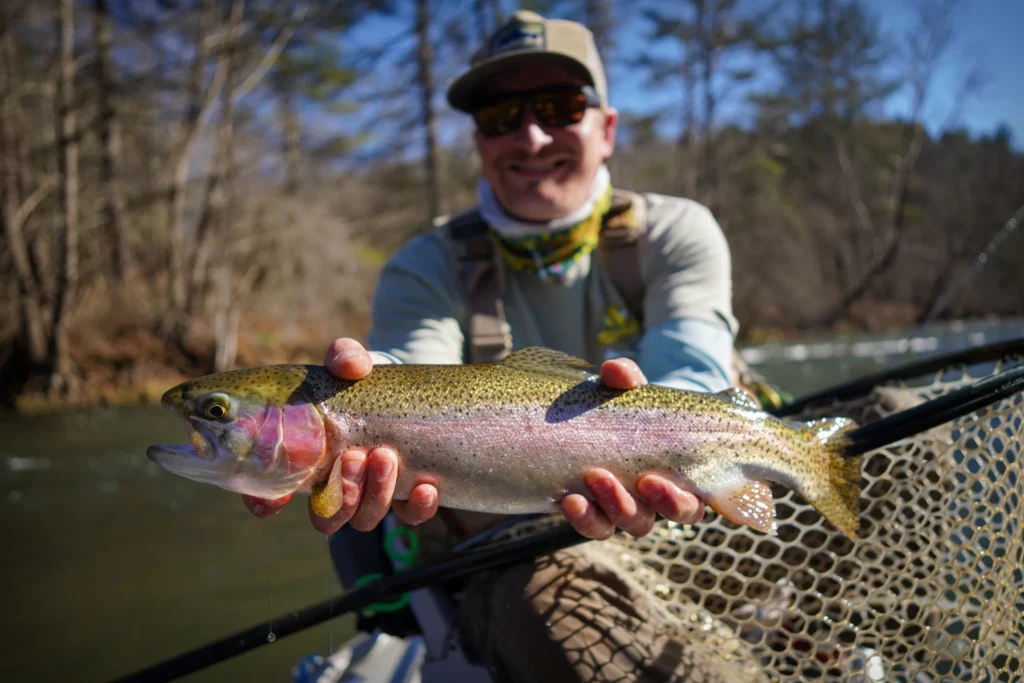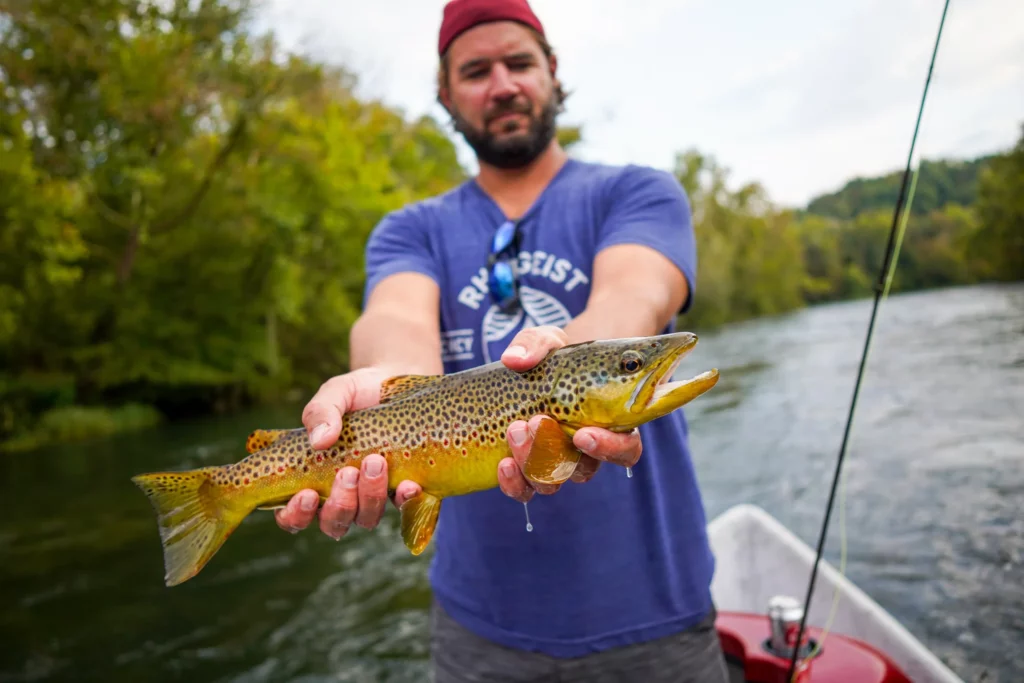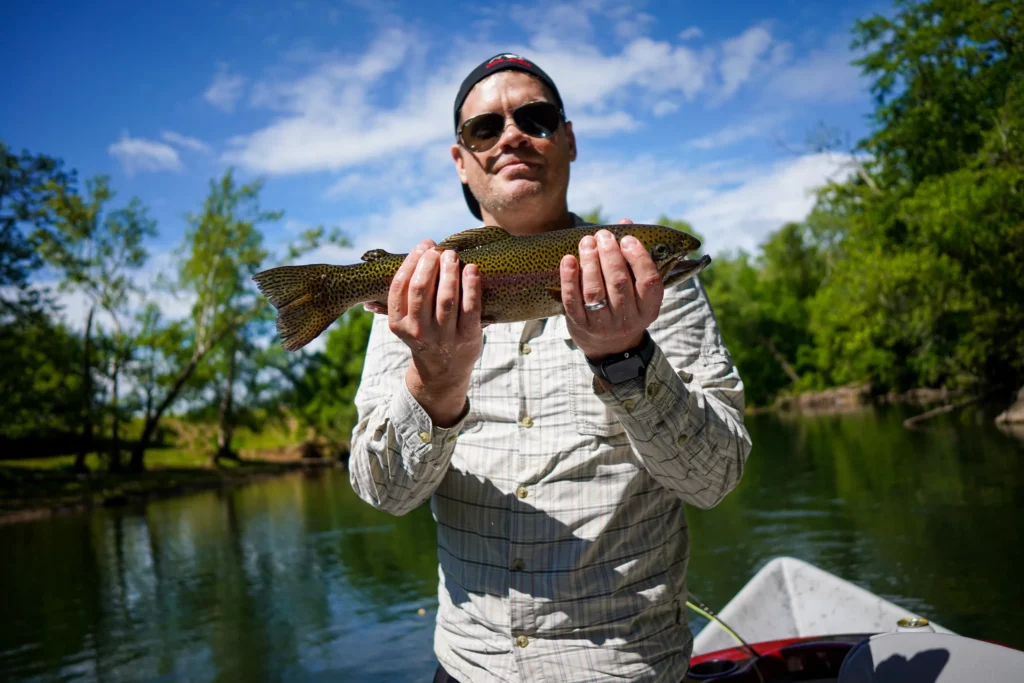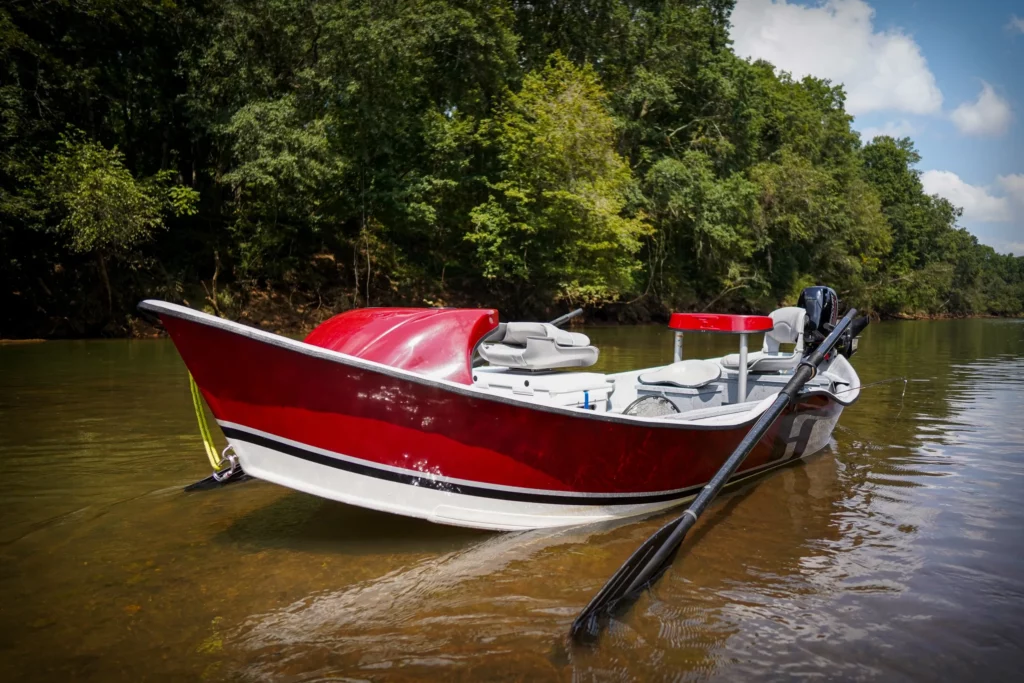Watauga River Trout Fishing
Welcome to the captivating tailwater section of the Watauga River, a premier destination for trout fishing in the Southeastern United States. Flowing from the depths of Watauga Lake in Elizabethton, Tennessee, this tailwater stretch is renowned for its consistent water temperature and flow, creating an ideal environment for a thriving trout population. Here, the river unveils a world where Rainbow and Brown trout flourish, attracting anglers from all corners who seek the thrill of fly fishing in these prolific waters. Paired with the South Holston River, this makes for an excellent weekend of fly fishing.
This tailwater section, with its controlled releases from the Wilbur Dam, offers a year-round fishing haven, unlike typical freestone rivers that can be heavily affected by weather and seasonal changes. The stable conditions not only support a rich aquatic ecosystem but also allow for a more predictable and rewarding fishing experience. It’s in these waters where both the novice and the seasoned fly fisher can find their rhythm, casting amidst the backdrop of the stunning Appalachian scenery.

The Watauga River tailwater’s reputation as a top trout fishing spot is well-earned. It’s a place where the challenges of fly fishing meet the beauty of nature, creating a symphony of experiences that resonate deeply with those who wade its currents. The river’s clear, cool waters, teeming with trout, promise not just a day of fishing, but an immersive journey into the heart of what makes Watauga River fly fishing in the Appalachian region truly exceptional.

Understanding the Watauga River Ecosystem
Delving into the Watauga River ecosystem reveals a vibrant and complex environment, intricately woven to support a thriving trout population. This tailwater, fed by the deep, cool releases from Wilbur Dam, maintains a consistent flow and temperature, crucial for sustaining diverse aquatic habitats. The riverbed, with its mixture of gravel, rock, and sand, coupled with abundant aquatic vegetation, provides ideal spawning and feeding grounds for trout. These conditions foster a rich food web, teeming with mayflies, caddisflies, and other invertebrates, essential for trout nourishment.
In the Watauga River, anglers find a trove of trout species, each adding to the river’s allure. The Rainbow Trout, with their iridescent hues, are a common sight, often found in the faster, oxygen-rich sections of the river. Brown Trout, elusive and cunning, prefer deeper pools and undercut banks, presenting a rewarding challenge for anglers.
This diverse trout ecosystem is a testament to the Watauga River’s health and resilience. Each species, adapting to the river’s dynamic environment, contributes to the rich fishing tapestry that the Watauga offers. Here, in the heart of Tennessee’s mountains, the river not only sustains an array of trout species but also captivates the hearts of those who seek the thrill of trout fishing in a pristine natural setting.
Best Times for Trout Fishing in the Watauga River
In the world of trout fishing, timing is everything, and the Watauga River is no exception. The river’s unique tailwater ecosystem offers year-round fishing opportunities, but understanding the seasonal variations in trout behavior is key to a successful catch.
Spring heralds some of the best fishing conditions on the Watauga. As the water warms, trout become more active, feeding aggressively in preparation for spawning. This is the time for dry flies and nymphs, with late afternoons being particularly fruitful as insects hatch in abundance.
Summer brings warmer temperatures and lower water levels, yet the consistent cool releases from the Wilbur Dam keep the trout active. Early mornings and late evenings are the prime times to avoid the heat and enjoy the vibrant activity of trout feeding on the surface.
Fall sees another peak in trout activity as they feed heavily in anticipation of the coming winter. Streamers and nymphs are highly effective during this period, especially during the midday when the water temperatures are ideal.
Winter challenges anglers with colder temperatures and slower fish metabolism, yet the river remains a viable fishing destination. Midday, when the water is warmest, is the optimal time to target the deep pools where trout congregate.
In reality, while the Watauga River offers year-round trout fishing, each season demands a different approach, with shifts in time of day and fishing techniques being crucial for a successful outing.
Fishing Techniques and Strategies
Fishing the Watauga River requires a blend of skill, knowledge, and the right equipment to effectively target its diverse trout population. Three predominant techniques stand out: nymphing, dry fly fishing, and streamer fishing, each requiring specific strategies and gear.
Nymphing
Nymphing is highly effective on the Watauga, particularly because trout in this river feed predominantly below the surface. Anglers should focus on imitating the natural nymphs found in the river, such as mayflies and caddisflies. A key strategy is to use a strike indicator for detecting subtle bites and adjusting the depth of your nymph to match where the trout are feeding. A medium-action fly rod, coupled with a weight-forward floating line, makes for an ideal setup, providing the sensitivity and control needed for nymphing.

Dry Fly Fishing
Dry fly fishing, with its allure and challenge, is equally rewarding on the Watauga. Dry fly fishing is particularly exciting during hatch periods when trout actively feed on the surface. For this technique, a lighter rod, such as a 4 or 5 weight, offers the delicacy needed for presenting dry flies effectively. It’s essential to match the hatch in terms of fly selection, closely mimicking the size, shape, and color of the insects trout are feeding on.
In terms of equipment, the choice of rod, reel, line, and flies depends on the targeted trout species. When targeting larger Brown and Rainbow trout, a sturdier rod and reel with a heavier weight line are advisable. Always ensure your gear is well-matched to the fishing technique and trout species for an optimal fishing experience on the Watauga River.
Streamer Fishing
In addition to nymph and dry fly fishing, streamer fishing is another effective technique on the Watauga River, particularly for targeting larger, more aggressive trout like Browns. Streamers mimic baitfish, leeches, or other larger prey, appealing to the predatory instincts of trout.
When streamer fishing, the key is to replicate the movement of prey in the water. This often involves casting across the current and retrieving the streamer in a manner that makes it swim or dart through the water, provoking a strike from predatory fish. Techniques such as the ‘strip retrieve’ or ‘swing technique’ are commonly used, depending on the water conditions and fish behavior.
For streamer fishing, a slightly heavier setup is advisable. A 6 to 7 weight rod provides the necessary power for casting larger streamers and handling bigger fish. A sinking or sink-tip line can be beneficial, especially when fishing deeper pools or faster currents where big trout often lie.
Streamer fishing can be particularly productive in the Watauga during early morning or late evening, or when the river is slightly discolored after rainfall, as trout tend to be more aggressive and less wary under these conditions. Varying your retrieve speed and pattern until you find what triggers strikes is a crucial aspect of successful streamer fishing on this dynamic river.

Fly Selection for Watauga River Trout Fishing
Selecting the right flies is a critical aspect of successful trout fishing on the Watauga River. This river, with its diverse habitats and conditions, demands a versatile fly box. Key patterns include nymphs, dry flies, and streamers, each serving a unique purpose depending on the river’s conditions and trout behavior.
Nymphs are a staple for the Watauga, with patterns like the Pheasant Tail, Hare’s Ear, and Copper John being particularly effective. These imitate the immature stages of aquatic insects, a primary food source for trout. During hatches, matching the specific species and size of the emerging insects with your nymphs can significantly increase your success.
Dry flies come into their own during hatch periods, typically in the warmer months. Classic patterns like the Adams, Elk Hair Caddis, and Blue-Winged Olives are excellent. Observing the types of insects trout are feeding on and choosing a similar pattern is key.
Streamers are ideal for targeting larger trout, especially Browns. Patterns like the Woolly Bugger or Sculpin imitations can be very effective, especially in deeper pools or during overcast conditions when trout are more likely to be active.
Adapting your fly selection based on weather and water conditions is crucial. Smaller, more natural patterns are effective on sunny days with clear water. In contrast, during overcast or murky conditions, larger flies and those with more flash or contrast can be more productive. The Watauga River’s dynamic ecosystem calls for a fly box as diverse as its trout population, ready to adapt to its ever-changing moods.
Local Regulations and Conservation Practices
Navigating the local regulations and embracing conservation practices are fundamental for maintaining the health and sustainability of the Watauga River’s trout population. Anglers should be well-informed about the specific rules that govern fishing in this area to ensure both a legal and environmentally responsible experience.
The Watauga River has designated sections with varied regulations. These may include restrictions on bait use, the type of hooks allowed (such as barbless hooks), and specific catch-and-release areas. It’s essential to check the current Tennessee Wildlife Resources Agency regulations for the latest rules, including any changes in size and bag limits, which can vary seasonally and by river section.

Practicing catch and release is a vital conservation effort on the Watauga River. This method allows for the enjoyment of fishing while minimizing harm to the trout, ensuring their populations remain robust for future generations of anglers. Proper catch-and-release techniques involve using barbless hooks for easier removal, handling the fish as little as possible, and keeping the trout in water to reduce stress and maintain their health.
In addition to catch and release, anglers are encouraged to engage in other conservation practices. This includes avoiding fishing during spawning periods, respecting wildlife and other anglers, and leaving no trace by removing all litter and fishing line debris. These practices help preserve the Watauga River’s pristine condition, making it a sustainable and thriving environment for trout fishing.
Guided Fishing Experiences on the Watauga River
Opting for a guided fishing experience with High Flying Flies Guide Service on the Watauga River can significantly enhance your fishing adventure. Led by experienced guide and owner Jason Bromwell, this service offers a deep understanding of the river’s ecosystem and trout behavior, ensuring a fulfilling and successful outing.
High Flying Flies specializes in tailoring their guided trips to the individual needs and skill levels of their clients. Whether you’re a novice angler eager to learn the basics or an experienced fisherman looking to refine your techniques, their expert guides provide personalized instruction and insights. From teaching effective casting methods to selecting the perfect fly based on current conditions, their guidance is invaluable.
What sets High Flying Flies apart is their intimate knowledge of the Watauga River’s best fishing spots and conditions. This local expertise allows anglers to maximize their time when on a Watauga or South Holston River trout fishing trip, increasing the likelihood of a memorable catch. Furthermore, their commitment to conservation and sustainable fishing practices ensures not only a great fishing experience but also the preservation of the Watauga River’s trout population for future generations.
By choosing High Flying Flies, anglers are assured of a comprehensive, educational, and enjoyable fishing experience, all while being immersed in the stunning natural beauty of the Watauga River.
That’s A Wrap!
In conclusion, the Watauga River stands as a beacon for trout fishing enthusiasts, offering a blend of scenic beauty and abundant fishing opportunities. Its reputation as a trout haven is well-earned, with the river’s clear, cool waters and diverse habitats creating an ideal environment for various trout species. From the vibrant Rainbow to the elusive Brown, the Watauga River caters to anglers of all interests and skill levels.
The river’s year-round accessibility, enhanced by the consistent conditions of its tailwater section, means every season brings its unique charm and challenges. Whether it’s the exhilarating hatches of spring, the serene summer evenings, the bountiful autumn, or the quiet beauty of winter, the Watauga River offers a distinctive fishing experience all year round.
For those looking to maximize their experience, High Flying Flies Guide Service, under the expert guidance of Jason Bromwell, provides an unmatched opportunity to explore the river’s riches. Their knowledge and commitment to conservation ensure not only a successful fishing trip but also an experience that respects and preserves this magnificent resource.
We encourage all fishing enthusiasts, whether seasoned anglers or curious beginners, to cast their lines into the waters of the Watauga River. The river is more than just a fishing destination; it’s a place where memories are made, skills are honed, and the beauty of nature is celebrated with every cast.
